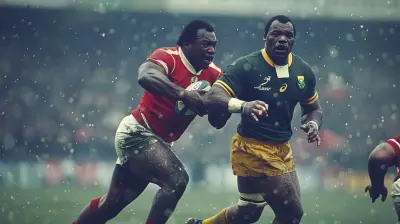20 November 2024
Scrum. Even the word itself sounds a bit chaotic, right? If you're new to rugby, the sight of two packs of players huddled together, shoving with all their might, can seem a little confusing. But behind what looks like sheer madness lies one of the most organized, strategic, and essential aspects of the game – the scrum.
So, what exactly is a rugby scrum? Why does it matter so much? And how do teams master this vital set piece to gain the upper hand on the pitch? Let’s dive deep into the world of scrums and uncover why it's often referred to as rugby’s most crucial set piece.

What is a Scrum?
A scrum is a way of restarting play in rugby, typically after a minor infringement like a knock-on (when a player fumbles the ball forward) or a forward pass. It involves eight players from each team binding together in three rows, forming a tight unit that pushes against the opposing team’s eight players.To visualize it, imagine two human tanks coming head-to-head, each trying to overpower the other and gain possession of the ball. It’s not just about brute force, though. A successful scrum requires coordination, timing, technique, and a sprinkle of cunning strategy. Think of it as a chess match where the pieces are 200-pound athletes locked in a physical contest for control.

Why is the Scrum So Important?
You may be asking yourself, “What’s the big deal? It’s just another play, right?” Wrong. The scrum can be a game-changer. Here's why:1. Possession of the Ball: The team that wins the scrum gets possession of the ball. This is a huge advantage, especially since the attacking team can launch their next move, often from a solid and organized platform.
2. Territorial Gain: If a team can dominate in scrums, they can push the opposing team back, gaining precious meters. This can be especially advantageous when you’re close to the opponent’s try line.
3. Psychological Edge: A dominant scrum can demoralize the opposition. It’s a show of force, and a well-executed scrum can send a message: "We’re stronger, and we’re coming for you."
4. Setting the Tempo: The scrum dictates the pace and rhythm of the game. A team with a strong scrum can control the flow, giving them more time to execute plays.

The Anatomy of a Scrum
To truly appreciate the scrum, it’s essential to understand the specific roles of the players involved. In rugby, the forwards are the ones responsible for participating in the scrum. They are divided into three rows:1. The Front Row
This is where the magic starts. The front row consists of three players: two props (loosehead and tighthead) and a hooker.- Loosehead Prop (No.1): Positioned on the left side of the scrum, the loosehead prop is responsible for binding onto the opponent’s tighthead prop. Their job is to destabilize the opposing scrum and protect the hooker.
- Tighthead Prop (No.3): On the right side of the scrum, the tighthead prop engages directly with the opposition’s loosehead prop. This position requires immense strength and technique to ensure the scrum remains solid.
- Hooker (No.2): The hooker stands between the two props and has the critical role of hooking the ball back to their team once the scrum is engaged. In many ways, they are the heartbeat of the scrum.
2. The Second Row
Behind the front row are the two locks, often referred to as the "engine room" of the scrum.- Locks (No.4 and No.5): These tall, powerful players bind tightly behind the front row and provide the bulk of the pushing force. Their primary job is to drive the scrum forward and provide stability.
3. The Back Row
The final row consists of three players: two flankers and a number eight.- Flankers (No.6 and No.7): Positioned on either side of the scrum, the flankers are responsible for providing additional power and support. They also have the flexibility to break off quickly and chase after the ball once it's out.
- Number Eight (No.8): The number eight anchors the scrum at the back. Their role is to control the ball once it reaches them and either pass it off or pick it up and run with it.

The Scrum Process
Now that we know who’s involved, let’s break down how a scrum actually happens. The process is highly regimented and follows a specific sequence to ensure safety and fairness.1. The Setup: Both teams line up facing each other. The front rows bind together, with the props locking onto their opposite numbers. The hookers are positioned in the middle, ready to strike at the ball.
2. The Engagement Sequence: The referee calls "Crouch, Bind, Set." On "Crouch," the players bend at the waist. On "Bind," they grip onto their opponents’ jerseys. And on "Set," the two packs come together, forming the scrum.
3. The Feeding of the Ball: The scrum-half (a player who isn't part of the scrum) rolls the ball into the tunnel between the two sets of front rows. This is called "feeding the scrum."
4. The Hook: The hooker’s job is to use their foot to hook the ball backward toward their own team. This action is where the scrum gets its name.
5. The Push: Both teams push against each other, trying to drive their opposition backward and gain control of the ball.
6. Release and Play: Once the ball reaches the number eight at the back of the scrum, they can either pass it out to the scrum-half or pick it up and run with it. The scrum is over, and open play resumes.
Techniques for a Successful Scrum
Winning a scrum is both an art and a science. Teams spend countless hours practicing scrum techniques, and for good reason. Here are some key elements to mastering the scrum:1. Body Positioning
A good scrum starts with proper body positioning. Players need to maintain a low, stable stance, with their backs flat and their heads up. This allows for maximum power transfer and minimizes the risk of collapsing the scrum. Poor positioning can lead to penalties or even dangerous situations.2. Synchronized Effort
Scrum success depends on all eight players working as a single unit. If even one player is out of sync, the scrum can be destabilized. Timing is everything, and teams practice endlessly to ensure that their push is perfectly coordinated.3. Controlled Aggression
While scrums are physical, they’re also highly controlled. Players need to channel their aggression in the right way, focusing on technique and timing rather than just brute strength. Over-aggression can lead to penalties or even injury.4. Communication
Clear communication is vital in the scrum. Players need to be constantly talking to each other, adjusting their positions, and making sure they’re all on the same page. The scrum-half, in particular, plays a critical role in directing the play once the ball is in the scrum.Common Scrum Penalties
While the scrum is a core part of rugby, it’s also one of the most penalized areas of the game. Here are some common infractions:- Early Engagement: If a team engages before the referee’s “set” call, they can be penalized.
- Collapsing the Scrum: If a team intentionally collapses the scrum to avoid being pushed back, it results in a penalty.
- Illegal Binding: Players must bind correctly onto their opponents. Failing to do so can result in a penalty.
- Feeding the Scrum: The scrum-half must feed the ball straight into the scrum. Feeding it at an angle to favor their team results in a free-kick to the opposition.
The Evolution of the Scrum
Over the years, the scrum has evolved, with rule changes aimed at improving player safety and ensuring fair play. In the early days of rugby, scrums were a bit of a free-for-all, with little regulation around engagement or safety.Today, however, the scrum is highly regulated, with referees closely monitoring the engagement process to prevent injuries. While some old-school fans might miss the days of wild, chaotic scrums, the modern version is a safer, more strategic affair.
Conclusion: The Scrum as a Game Decider
Mastering the scrum is essential for any rugby team that wants to dominate the field. While it may seem like just another part of the game, the scrum can be the difference between winning and losing. A powerful scrum can provide a platform for attacking plays, give a team valuable territorial advantage, and even break the spirit of an opposition.So next time you’re watching a rugby match, don’t just see the scrum as a pause in the action. Instead, appreciate the strategy, the technique, and the sheer physicality involved. Because in rugby, the scrum is more than just a set piece – it's the heart of the battle.

![The Quiet Dominator: How [Player Name] Lets Their Game Do the Talking](/pictures/blog/small/the-quiet-dominator-how-player-name-lets-their-game-do-the-talking_4.webp)





![What Makes [Player Name] Unstoppable: A Look at Their Key Strengths](/pictures/blog/small/what-makes-player-name-unstoppable-a-look-at-their-key-strengths_4.webp)


![Beyond the Stats: The Leadership of [Player Name] On and Off the Field](/pictures/blog/small/beyond-the-stats-the-leadership-of-player-name-on-and-off-the-field_4.webp)

Arlo McElroy
Great insights on scrumming! Your analysis highlights its importance in rugby strategy. Excited to see how teams apply these techniques in upcoming matches. Keep up the fantastic work!
April 7, 2025 at 4:52 AM